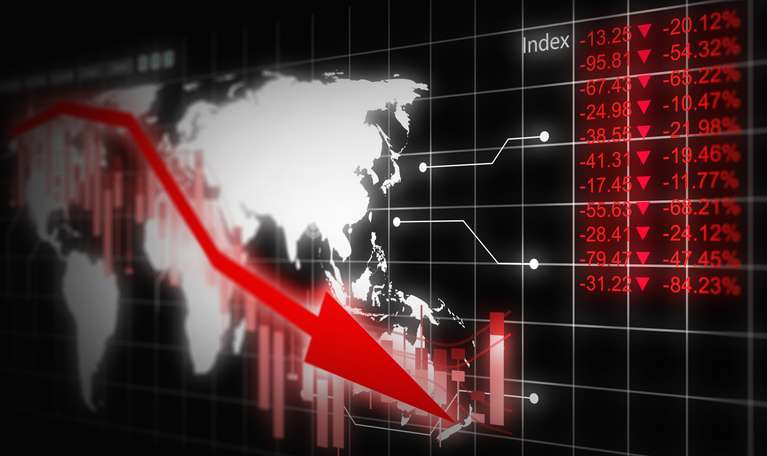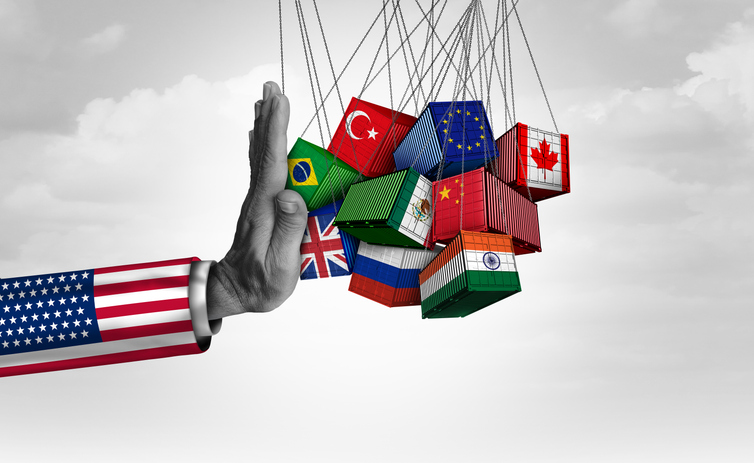Tariffs may not be enough to curb US trade deficit
While the US is turning to tariffs in an attempt to rebalance its widening trade deficit, deeper structural forces are also in play – most notably, the world’s enduring trust in the US as a safe harbor for capital.
In April, President Donald Trump shocked markets by announcing the largest tariff hike in US history, sending effective tariff rates surging from 2.5% to 22.5%. The primary stated goal – reduce the country’s persistent trade deficit.
But whether tariffs can meaningfully address the imbalance is just one part of the puzzle. The bigger question is why the US has run trade deficits for nearly 50 years – and how this is linked to sustained foreign borrowing on a vast scale.
***
Get weekly insights from The Intuition Finance Digest. Elevate your understanding of the finance world with expertly-crafted articles and podcasts sent straight to your inbox every week. Click here: https://www.intuition.com/finance-insights-the-intuition-finance-digest/
***
US current account deficit – a permanent feature for over 50 years
Since the 1970s, the US has consistently imported more than it exports. More recently, the gap has widened sharply. The current account deficit has doubled since 2019, and US net liabilities to the rest of the world have climbed to 90% of GDP – an all-time high.
Prior to the COVID-19 pandemic, the trade deficit appeared more manageable, with net foreign liabilities relatively stable around 50% of GDP. But the pandemic-era policy response – in particular, aggressive fiscal stimulus – upended that equilibrium. This was compounded by the strong performance of the US tech sector and a booming stock market, both of which helped drive the dollar higher.
A stronger dollar made imports cheaper, further widening the deficit. Today, the trade gap stands at around 4% of GDP. Economists generally agree that a reduction of at least 2% of GDP would be needed to bring the external position back toward sustainability.
And that estimate doesn’t even account for changes in borrowing costs. If financing conditions were to tighten – whether through higher interest rates, reduced investor appetite, or broader market stress – the adjustment required could be significantly more painful.
This isn’t the first time the US has faced large and growing imbalances. Similar episodes occurred in the early 1980s and mid-2000s.
During the 2008 financial crisis, the US trade deficit narrowed – but not due to deliberate policy changes. The sharp contraction in domestic demand and global trade led to a steep drop in imports. Despite originating in the US, the crisis triggered a global flight to safety, and the dollar in fact strengthened as investors liquidated risk assets and sought refuge in US Treasuries.

Structural drivers of US trade deficit
Cheap imports from China and the effects of globalization are often blamed for the US trade deficit. But the real drivers are deeper and more structural – tied to capital flows as much as trade dynamics.
While the US persistently runs trade deficits, it consistently runs a capital account surplus – global investors are eager to buy US assets, and that inflow of foreign capital effectively finances the trade gap. The two accounts are mirror images in balance-of-payments terms – when foreign capital floods in, the US can afford to import more than it exports.
But these inflows don’t happen in a vacuum. Since the 2008 crisis, US assets have gained renewed appeal, not only because of the dollar’s reserve role, but also due to the policy response itself. The US moved early and forcefully with monetary and fiscal stimulus, reinforcing the depth, liquidity, and perceived safety of its capital markets. This stood in contrast to a slowdown in emerging markets, which had drawn investor attention earlier in the 2000s, as well as the EU’s more hesitant and drawn-out response to the sovereign debt crisis that followed the GFC.
At the same time, the tech boom that followed the GFC and persists until today (now spearheaded by AI) has supercharged US equity markets, providing another reason for global investors to pile into US assets.
The result is a kind of structural privilege – high and stable demand for US assets keeps the dollar strong and interest rates low, making imports cheaper and eroding the incentive to save. In effect, global capital inflows help sustain the very imbalances they’re supposed to correct.

Mounting debt, waning confidence
Foreign appetite for US assets cannot be taken for granted. When President Trump announced tariff hikes, Treasury prices fell and the dollar weakened in early signs that investor confidence may be fraying.
Today, markets are increasingly sensitive to the risks of unsustainable US fiscal policy amid heightened geopolitical tensions. Yet despite growing concerns, the US continues to borrow aggressively, even as it strains trade relationships.
At the same time, skepticism is growing about how well official statistics capture America’s true external position. Corporate profit-shifting to low-tax jurisdictions likely understates US exports and distorts reported investment income. Some researchers estimate this could mean the current account deficit is overstated by as much as 1% of GDP.
Conversely, recent all-time highs in US equity markets – fuelled by the seemingly interminable tech boom, soaring bitcoin prices, and a revival of meme stocks – may be inflating the market value of foreign-held US assets. This can lead to an overstatement of US liabilities on paper, reflecting valuation gains rather than new borrowing.
Meanwhile, structural demand for US assets is showing signs of softening. Major economies such as Germany are increasing domestic spending and investment, reducing their reliance on dollar assets. This evolving landscape may dampen the steady capital inflows that have long financed US external deficits, adding to pressure on the dollar.
For all these nuances in accounting and demand, one thing is clear – the US is accumulating foreign debt rapidly, and the global willingness to finance it is not unlimited.
Markets dive after Trump hits more countries with steep tariffs

The dollar privilege and its limits
For decades, the US has benefited from what economists call an “exorbitant privilege” – a status conferred by the dollar’s dominance as the global reserve currency.
One manifestation of this privilege is that the US earns more on its foreign investments than it pays to foreign holders of US assets. This income asymmetry has long allowed the country to run deficits without immediate financial pressure.
But that privilege is rooted in trust. The post-COVID surge in the trade deficit, combined with the ballooning net liability position, has started to raise red flags. If the US loses its ability to borrow at low cost, the eventual adjustment could be severe, impacting markets, businesses, and households alike.
Turning point?
Tariffs alone are unlikely to resolve the US trade imbalance. That’s because the deficit isn’t just about trade – it’s about national savings, investment behavior, and the world’s hunger for US assets.
Unless the US addresses its fiscal policies and rethinks its role in the global financial system, the trade gap will remain. And the day may come when the US is no longer the world’s overwhelmingly preferred destination for capital.
If global confidence falters, borrowing costs could rise sharply, forcing a painful reckoning with America’s external imbalances. What happens next will hinge on the policy choices made today, and whether the US can preserve the trust it has long taken for granted.
Intuition Know-How, a premier digital learning solution for finance professionals, has several tutorials relevant to the content of this article:
- Trade Indicators
- Economic Indicators – An Introduction
- Fiscal Policy Analysis
- US Equity Market
- US Bond Market
- Foreign Exchange (FX) Market – An Introduction
Browse full tutorial offering



